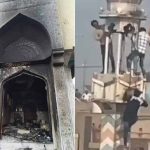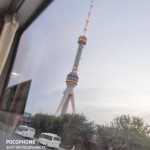Dr. S. Bushra Batool
After the fall of Damascus, following the collapse of the final military positions and the resulting paralysis of all remaining state institutions, the Islamist movement Hayat Tahrir al-Sham (HTS) has set itself up as the main component of the country’s new leadership. Yet, many other armed groups, with, at times, divergent objectives, are still active in Syria. As Syrian cities and provinces fell to rebels led by the Islamist militant group HTS, dancing crowds gathered on the streets to celebrate the end of the Assad regime.
Despite that one phase of Syria’s civil war is over, another might begin. The “Islamic nationalists” of Hayat Tahrir Al-Sham, who have become Syria’s new leading force; the Syrian National Army (SNA); Kurdish militias from the country’s northeast; the jihadists of the Islamic State (IS) organization: The Syrian civil war has given rise to a multi-faceted insurgency, whose components often pursue objectives that are antagonistic to each other, operating under the influence of several external parties.
Syria might be entangled in another episode of terror. “Danger of IS resurgence has doubled,” Syria’s Kurds warn of group’s comeback. Senior international correspondent of BBC, while reporting from Al-Sina Prison, North East of Syria, expressed her concerns that the current chaos in Syria could be exploited to release the IS detainees.
This was supported by the members of the Syrian Democratic Forces (SDF), a mainly Kurdish militia alliance backed by the US. The organization’s Commander General Mazloum Abdi opined that the activity by IS had increased significantly, and the danger of a resurgence had doubled’, His claims are aligned with the fact that the IS now has more capabilities and more opportunities to seize some arms and ammunition left behind by Syrian regime troops, according to intelligence reports.
The chaos since the overthrow of Bashar al-Assad is “paving the way” for the so-called Islamic State (IS) to make a comeback, according to a leading Kurdish commander who helped defeat the jihadist group in Syria in 2019. He says the comeback has already begun. However, the de facto leader of Syria, Ahmed al-Sharaa, has said the country is exhausted by war and is not a threat to its neighbours or the West.
The new leader seems confident in his approach and it is seen interviewing international media. In an interview with the BBC in Damascus, he called for sanctions on Syria to be lifted. “Now, after all that has happened, sanctions must be lifted because they were targeted at the old regime. The victim and the oppressor should not be treated in the same way,” he said. He added that HTS should be de-listed as a terrorist organization. It is designated as one by the UN, US, EU, and UK, among many others, as it started as a splinter group of al-Qaeda, which it broke away from in 2016.
While answering a question about the standards of living and rights of women in Syria, although Sharaa claimed that the future of Women in Syria is and he believed in education for women. “We’ve had universities in Idlib for more than eight years,” Sharaa said, with more than 60 percent of women’s ratio in universities in Syria’s north-western province that has been held by rebels since 2011.
While categorically rejecting any resemblance of Syria to that of Afghanistan, Sharaa said the countries were very different, with different traditions. Afghanistan was a tribal society. In Syria, he said, there was a different mind-set. The assurances of Sharaa although provide breathing room for the people of Syria, yet not all Syrians believe him. It is only a matter of time before they will decide the kind of country they want Syria to be – and the way they want to rule it.
Stakes of regional actors in Syria
The influence of Moscow on Syrian affairs is evident from its military presence in the country. Russia had a significant military presence in Syria during Bashar al-Assad’s rule – helping him stay in power after the outbreak of the civil war in 2011.
Its two most significant bases are the port at Tartous, established by the Soviet Union in the 1970s and then expanded and modernized by Russia in 2012, and the airbase at Hmeimim, which has been operational since 2015 and was used to launch air strikes across Syria in support of Assad.
Awarded for a 49-year lease granted to Russia by Syrian authorities, both have become key strategic bases for Russia – giving it easier access to the Middle East, North Africa and the Mediterranean Sea. However, the fall of Assad has raised questions about Russia’s future presence in Syria. Moscow is seeking to negotiate with the new regime. Satellite images reveal a build-up of military vehicles at a Russian-controlled port and airbase in western Syria, signalling preparations for a partial withdrawal.
“Russia is now withdrawing units and military equipment that were deployed in nearly a hundred strongholds across the country before the fall of Damascus,” said Anton Mardasov, a non-resident scholar in the Middle East Institutes Syria program. The withdrawal of Russia from Syria would be a great setback for Russia’s key objectives had been to assert itself as a global power.
It indicates that although Russia, who had been pouring its resources in the Syrian war for a decade, is not indifferent to what is happening in Syria, however, for Russia, the priority is its own security especially in the context of what is happening in the zone of the Special Military Operation, the war of Russia in Ukraine.
The US and the West
The US and the UK had been close observers in the situation and happenings of Syria being a staunch critic of Assad’s regime. In the days before the fall of the Assad regime and in the following days, the US and the UK had been in touch with HTS. The British government made clear the Islamist-led rebel group remains a proscribed terrorist organization, despite it beginning “diplomatic contact” with the group. Both want the future of Syria free of Iranian and Russian influence. Although Russia and Iran might have gone to the background, at least to recover from past injuries, many power players are still there in Syria.
Iran
After the assassination of a former leader of Lebanon’s Hezbollah movement, Hassan Nasrallah, Former Iranian President Ebrahim Raisi, and the killing of Hammas leader Ismail Haniyeh along with other top Iranian Generals in Tehran, as recently confirmed by Israel, and Iran’s Quds force General Qassem Soleimani, among many other nuclear scientists and leaders, Iran has yet faced with another blow in form of losing a pivotal state and partner in its axis of resistance with the fall of a key ally, Syrian President Bashar al-Assad.
The regional equation and the future of Syria
In this new equation of changing geopolitics and with the new president-elect Donald Trump coming to power on January 20, 2025, it is yet to be seen whether Iran prepares for a new Donald Trump presidency with a more hard-line approach – or will it renew negotiations with the West. Ayatullah Khamenei, an 85-year-old Iranian Supreme Leader reiterates that “Iran is strong and powerful and will become even stronger.” He added that the Iran-led alliance in the Middle East, which includes Hamas, Hezbollah, Yemen’s Houthis, and Iraqi Shia militias the “scope of resistance” against Israel would only strengthen. This reflects the continued stance of Iran in the time to come.
Additionally, the regional stability seems to be hardly achievable. With the insane aggression of Israel and the support it enjoys from the US and European allies, seems to have achieved many of their desired targets. As James Jeffrey, a former US diplomat and deputy national security advisor said, “All the dominoes have been falling.”
The question about the future of Syria with an upcoming regime is important. Over a decade-long war in Syria and the oppression and subjugation suppressing opposition voices, in addition to the power tussle and subsequent devastations have grappled Syria into a chaos that is going to take years to recover. In March 2024, the UN Office for Coordination of Humanitarian Affairs (UNOCHA) estimated that 16.7 million people in Syria were expected to require humanitarian assistance, the highest since 2011 and representing 71% of the population.
This included 3.5 million people in Aleppo and 2.6 million in Idlib. UNOCHA also estimated that 12.9 million people are food insecure. The price of a standard food basket was 133 times higher in 2023 than in 2013. There has been substantial economic disruption. In 2024 the World Bank said the Syrian economy shrank 54% from 2010 to 2021 and Assad government expenditure was 87% lower in 2023 compared with 2010, with reductions in social security and food and gas subsidies.
The country is also still grappling with the aftermath of severe human and material damage from catastrophic earthquakes and aftershocks in February 2023. Years of conflict have forced many children and families to flee to safer areas, resulting in considerable internal displacement.
From March 2011, when Syria’s government, led by President Bashar al-Assad, faced an unprecedented challenge to its authority with pro-democracy protests erupting throughout the country, to collapsing military support to the government in late November 2024 paving the way to a rapid offensive by opposition forces and the subsequent toppling of the regime, Syria has witnessed so much of pain, destruction, and terror.
The country’s protracted civil war saw hundreds of thousands of Syrians killed and nearly fourteen million people more than half the pre-war population displaced. Today, Syria remains a deeply impoverished and fractured state, with large parts of its territory controlled by different armed groups with varying affiliations with foreign powers. Iran, Israel, Turkey, Russia, and the United States were all drawn into the conflict either directly or indirectly over the years.
The Turkey-backed HTS and US-backed Syrian Democratic Forces (SDF), among other smaller factions going to pose serious threats to the stability of the country and may create another civil-war-like situation. The clashes have already begun in post-Assad Syria. The US-allied Syrian Democratic Forces (SDF) said five of its fighters had been killed on Saturday in attacks by Turkish-backed forces on the city of Manbij in northern Syria. T
He U.S. State Department said on Wednesday a ceasefire around Manbij had been extended until the end of the week, but a Turkish defense ministry official said a day later there was no talk of a ceasefire deal with the SDF. Moreover, the actions of Syria’s new rulers in the next few months will indicate the kind of country they want Syria to be and the way they want to rule it.
The author is a Research Officer at Rabita Forum International (RFI).










